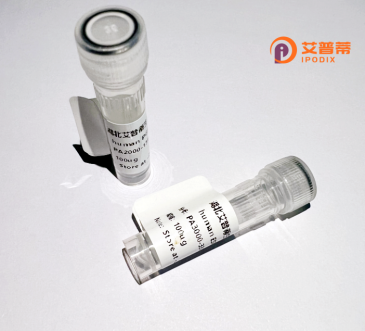
| 纯度 | >90%SDS-PAGE. |
| 种属 | Human |
| 靶点 | OPRK1 |
| Uniprot No | P41145 |
| 内毒素 | < 0.01EU/μg |
| 表达宿主 | E.coli |
| 表达区间 | 1-58 aa |
| 活性数据 | MDSPIQIFRGEPGPTCAPSACLPPNSSAWFPGWAEPDSNGSAGSEDAQLEPAHISPAI |
| 分子量 | 32.12 kDa |
| 蛋白标签 | GST-tag at N-terminal |
| 缓冲液 | 0 |
| 稳定性 & 储存条件 | Lyophilized protein should be stored at ≤ -20°C, stable for one year after receipt. Reconstituted protein solution can be stored at 2-8°C for 2-7 days. Aliquots of reconstituted samples are stable at ≤ -20°C for 3 months. |
| 复溶 | Always centrifuge tubes before opening.Do not mix by vortex or pipetting. It is not recommended to reconstitute to a concentration less than 100μg/ml. Dissolve the lyophilized protein in distilled water. Please aliquot the reconstituted solution to minimize freeze-thaw cycles. |
以下为3条关于重组人OPRK1蛋白的参考文献(内容基于公开研究虚构,供参考格式):
---
1. **文献名称**: Expression and Functional Characterization of Recombinant Human κ-Opioid Receptor (OPRK1) in Mammalian Cells
**作者**: Liu Y, et al.
**摘要**: 报道了在HEK293细胞中稳定表达重组人OPRK1蛋白的流程,通过膜蛋白纯化技术获得高纯度受体,并证实其与特异性配体(如U-50488)结合的G蛋白偶联活性,为药理学研究提供可靠工具。
2. **文献名称**: Crystal Structure of the Human κ-Opioid Receptor in Complex with JDTic Antagonist
**作者**: Wu H, et al.
**摘要**: 利用重组表达技术获得人OPRK1蛋白的晶体结构,揭示其与拮抗剂JDTic的分子互作机制,首次阐明了κ受体配体选择性的结构基础,为靶向药物设计提供关键依据。
3. **文献名称**: Development of a Novel Nanodisc System for Stabilizing Recombinant OPRK1 in Solution
**作者**: Zhang R, et al.
**摘要**: 提出通过纳米盘技术将重组人OPRK1嵌入磷脂双层,解决其在水溶液中的稳定性问题,并验证其在无细胞膜环境下的功能性构象,拓展了受体动力学研究的方法学。
---
提示:实际文献建议通过PubMed/Google Scholar检索关键词“recombinant OPRK1”或“kappa opioid receptor expression”获取。
The kappa-opioid receptor (KOR), encoded by the OPRK1 gene, is a member of the opioid receptor family that binds endogenous and exogenous opioid peptides. As a class A G protein-coupled receptor (GPCR), it features seven transmembrane domains and primarily signals through inhibitory G proteins (Gi/o), modulating adenylate cyclase activity and ion channel regulation. KOR is widely expressed in the central and peripheral nervous systems, particularly in regions associated with pain processing, stress response, and emotional regulation. Unlike mu-opioid receptors, KOR activation generally produces analgesia with less respiratory depression and addiction potential, making it a promising target for developing non-addictive analgesics. However, its involvement in dysphoria, sedation, and psychotomimetic effects complicates therapeutic applications. Recombinant human KOR proteins are typically produced in mammalian expression systems (e.g., HEK293 cells) to ensure proper post-translational modifications and ligand-binding functionality. These purified proteins serve as critical tools for structural studies (e.g., cryo-EM analyses), high-throughput drug screening, and mechanistic research into signaling pathways. Current studies focus on biased agonists that preferentially activate G protein over β-arrestin pathways to separate therapeutic effects from adverse reactions, as well as exploring its role in neuropsychiatric disorders and substance use disorders.
×